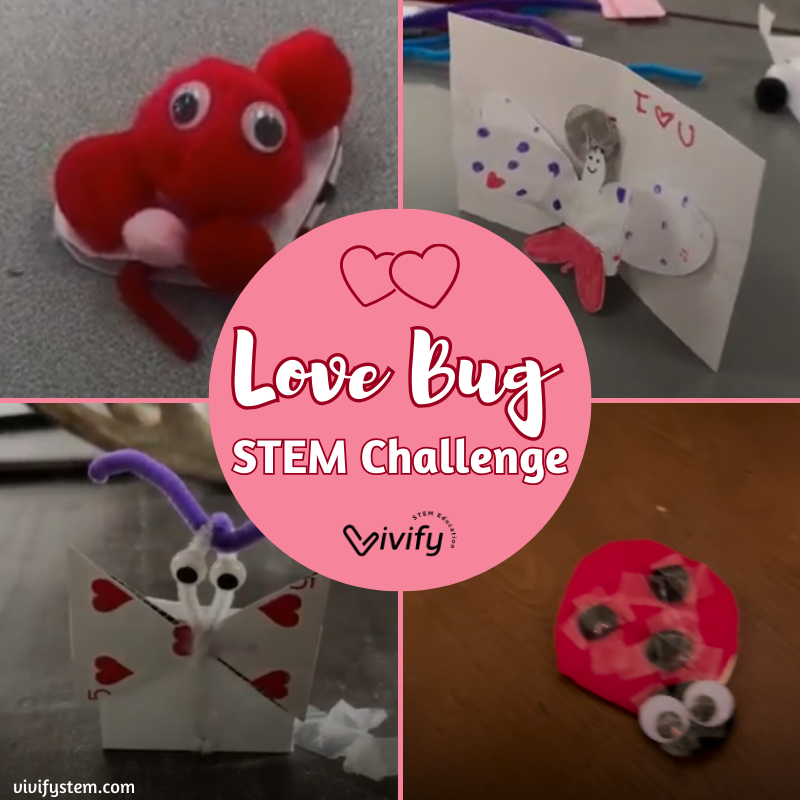Celebrate Valentine's Day with the Love Bug STEM Challenge!
Post by Dr. Natasha Wilkerson & Robin Bottini
Posted: January 20, 2025
This Valentine's Day, ditch the store-bought cards and use your engineering and creativity to make an adorable Love Bug for your valentine or friends! Read below for our free Love Bug Valentine’s Day STEM activity, which will result in the cutest of critters! This hands-on challenge blends engineering, creativity, problem-solving, and circuit science for an unforgettable experience that will set hearts racing and motors buzzing! Perfect for grades 4 and up, I even tested it with my undergraduate elementary education students, and they were in love with this project!
Love Bug STEM Challenge Overview
For this Valentine’s Day STEM Activity, your mission is to design and build a one-of-a-kind Love Bug that will wow your friends (or valentine) with a special message. With a mix of creativity and science, you’ll bring your Love Bug to life by transforming electrical energy into mechanical energy to make it move. Let’s get started and spread the love!
Mission: Build a Love Bug to deliver a message to your friends.
Rules of the challenge:
Must move 3 inches
Has a message
May move freely or along a track
Download the full lesson FREE in the STEM Space Explorer Library!
(Includes editable student handouts, teacher slides, and more!)
Valentine’s Day STEM Activity Instructions
1: Gather Your Materials
Each Love Bug needs a few key items to come to life:
Coin cell battery (3V)
Vibrating motor - make sure it is compatible with the 3V battery!
Option 1: Flat coin button - this one is easier to integrate in the design but not as powerful.
Option 2: Spinning motor - this one is stronger, but students will need to make sure the spinning part is not being blocked.
Craft materials like pipe cleaners, cotton balls, paper, and googly eyes for decoration - the options are endless! Keep in mind that it needs to be light.
Watch the video below for an explanation on how to connect the motor and battery.
Watch the video for a similar design challenge that includes an explanation on how to use the motor and battery.
2: Learn the Science
Discover how open and closed circuits work and how they power your Love Bug. This is an excellent opportunity to dive into the basics of electricity and energy transformation.
3: Design Your Bug
Before building, brainstorm your ideas. Think about - What are the different kinds of bugs? What are the parts of bugs? Then, sketch your Love Bug design, label the materials, and consider how you’ll make it move at least 3 inches. You also need to make sure you can connect the vibrating motor and battery to make your bug move! How will you capture this energy?
4: Build and Test
Assemble your Love Bug, ensuring the motor is securely attached and the circuit is closed. Test your bug on a flat surface, measure how far it travels, and make modifications as needed. Some tips for success:
Keep your design lightweight and balanced to ensure smooth movement.
Make sure nothing is blocking the spinning motor
Make adjustments to the circuit if the motor isn’t running—a closed circuit is key!
Use feedback from peers to improve your Love Bug’s performance
5: Reflect and Share
After testing, reflect on your process. What worked? What didn’t? Share your design with others and give peer feedback to inspire future improvements. Also, make sure to share it with a special message to your Valentine!
Ready to spread the love? Share your Love Bug creations on social media with the hashtag #VivifyLoveBug, and let’s see how far these little bugs can go! We hope you enjoyed this Valentine’s Day STEM Activity!
Remember, you can download the full lesson FREE in the STEM Space Explorer Library!
(Includes editable student handouts, teacher slides, and more!)





